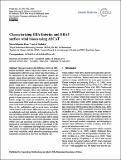Por favor, use este identificador para citar o enlazar a este item:
http://hdl.handle.net/10261/188692COMPARTIR / EXPORTAR:
 SHARE SHARE
 CORE
BASE CORE
BASE
|
|
| Visualizar otros formatos: MARC | Dublin Core | RDF | ORE | MODS | METS | DIDL | DATACITE | |

| Título: | Characterizing ERA-Interim and ERA5 surface wind biases using ASCAT |
Autor: | Belmonte Rivas, María CSIC ORCID; Stoffelen, Ad | Fecha de publicación: | jun-2019 | Editor: | European Geosciences Union | Citación: | Ocean Science 15: 831-852 (2019) | Resumen: | This paper analyzes the differences between ERA-Interim and ERA5 surface winds fields relative to Advanced Scatterometer (ASCAT) ocean vector wind observations, after adjustment for the effects of atmospheric stability and density, using stress-equivalent winds (U10S) and air-sea relative motion using ocean current velocities. In terms of instantaneous root mean square (rms) wind speed agreement, ERA5 winds show a 20 % improvement relative to ERA-Interim and a performance similar to that of currently operational ECMWF forecasts. ERA5 also performs better than ERA-Interim in terms of mean and transient wind errors, wind divergence and wind stress curl biases. Yet, both ERA products show systematic errors in the partition of the wind kinetic energy into zonal and meridional, mean and transient components. ERA winds are characterized by excessive mean zonal winds (westerlies) with too-weak mean poleward flows in the midlatitudes and too-weak mean meridional winds (trades) in the tropics. ERA stress curl is too cyclonic in midlatitudes and high latitudes, with implications for Ekman upwelling estimates, and lacks detail in the representation of sea surface temperature (SST) gradient effects (along the equatorial cold tongues and Western Boundary Current (WBC) jets) and mesoscale convective airflows (along the Intertropical Convergence Zone and the warm flanks for the WBC jets). It is conjectured that large-scale mean wind biases in ERA are related to their lack of high-frequency (transient wind) variability, which should be promoting residual meridional circulations in the Ferrel and Hadley cells | Descripción: | Special issue The Copernicus Marine Environment Monitoring Service (CMEMS): scientific advances.-- 22 pages, 18 figures, 1 appendix.-- Data availability. All the research data used in this paper can be accessed at Copernicus Marine Environment Monitoring Service (CMEMS). Global surface winds (ASCAT and ERA): http://marine.copernicus.eu/services-portfolio/access-to-products/?option=com_csw&view=details&product_id=WIND_GLO_WIND_L3_REP_OBSERVATIONS_012_005 (KNMI, 2018). Global ocean currents: http://marine.copernicus.eu/services-portfolio/access-to-products/?option=com_csw&view=details&product_id=MULTIOBS_GLO_PHY_NRT_015_003 (CLS, 2018) | Versión del editor: | https://doi.org/10.5194/os-15-831-2019 | URI: | http://hdl.handle.net/10261/188692 | DOI: | 10.5194/os-15-831-2019 | Identificadores: | doi: 10.5194/os-15-831-2019 issn: 1812-0784 e-issn: 1812-0792 |
| Aparece en las colecciones: | (ICM) Artículos |
Ficheros en este ítem:
| Fichero | Descripción | Tamaño | Formato | |
|---|---|---|---|---|
| Belmonte_et_al_2019.pdf | 40,05 MB | Adobe PDF |  Visualizar/Abrir |
CORE Recommender
SCOPUSTM
Citations
182
checked on 24-mar-2024
WEB OF SCIENCETM
Citations
166
checked on 06-feb-2024
Page view(s)
182
checked on 18-abr-2024
Download(s)
539
checked on 18-abr-2024
Google ScholarTM
Check
Altmetric
Altmetric
Este item está licenciado bajo una Licencia Creative Commons

